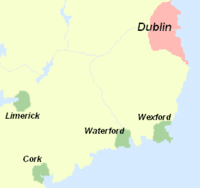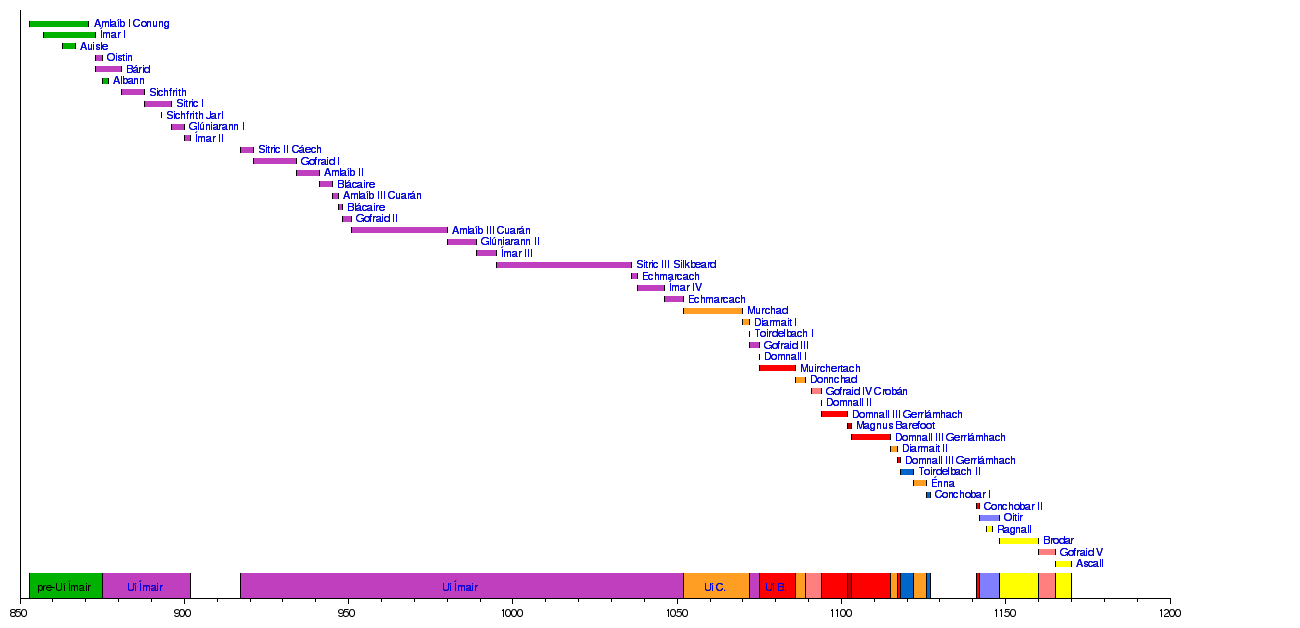Kingdom of Dublin facts for kids
Quick facts for kids
Kingdom of Dublin
Dyflin
Duibhlinn |
|||||||||||
|---|---|---|---|---|---|---|---|---|---|---|---|
| 853–1170 | |||||||||||

Maximum extent of Dublin (pink) and other Norse settlements (green) in Ireland
|
|||||||||||
| Capital | Dublin | ||||||||||
| Common languages | Old Norse, Old and Middle Irish |
||||||||||
| Religion | Norse paganism Roman Catholicism |
||||||||||
| Government | Monarchy | ||||||||||
| King | |||||||||||
|
• c. 853–871 (first)
|
Amlaíb Conung | ||||||||||
|
• c. 1160–1170 (last)
|
Ascall mac Ragnaill | ||||||||||
| History | |||||||||||
|
• Established
|
853 | ||||||||||
|
• Norman conquest
|
1170 | ||||||||||
| Currency | Silver penny | ||||||||||
|
|||||||||||
| Today part of | Ireland | ||||||||||
The Vikings arrived in Ireland in the 9th century. They settled around Dublin and created the Kingdom of Dublin. This was the first and longest-lasting Viking kingdom in Ireland.
The kingdom covered most of what is now County Dublin. The Vikings called their kingdom Dyflin. This name comes from the Irish words Dubh Linn, meaning "black pool."
Historians first learned about the Vikings in Ireland from old writings. These writings mention "pagans" on Lough Neagh in 841 AD. They also talk about "longphorts," which were ship fortresses. These were places where Vikings could stay through the winter. The exact spot of Dublin's longphort is still a mystery.
Viking rulers of Dublin were often co-kings. Sometimes, they were also kings of Jórvík in what is now Yorkshire, England. Under their rule, Dublin became a very important trading center.
Over time, the Viking settlers in Dublin started to adopt Irish ways. They mixed their Norse culture with Irish culture. These people are often called Norse-Gaels.
Contents
Where Was the Kingdom of Dublin?
The size of the Kingdom of Dublin changed over time. During peaceful periods, it stretched quite far. It reached Wicklow in the south. It also went to Glen Ding near Blessington. To the west, it included Leixlip. In the north, it reached Skerries, Dublin. The area north of Dublin, called Fingal, got its name from the Norse people who lived there.
Important Events in Dublin's History
The First Irish Takeover
In 988, an Irish king named Máel Sechnaill mac Domnaill conquered Dublin. Some people count the founding of Dublin from this year. However, a village had existed on the site for almost a thousand years before that.
Making Coins
Around 995, Dublin started making its own coins. These were likely silver pennies. This shows how important Dublin was as a trading hub.
End of the Kingdom
In the mid-11th century, the Kingdom of Leinster started to have power over Dublin. The last king of Dublin was killed in 1171. This happened during the Norman conquest of Dublin. Even after this, the people of Dublin kept their unique culture for many years.
Kings of Dublin Timeline
Many different kings ruled Dublin over the centuries. Some were Vikings, and others were Irish. They often fought for control of this important city. The timeline below shows when different groups and kings ruled Dublin.

See also
- Irish nobility
- The Pale
- Uí Ímair

